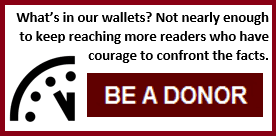Torture, American-style
By Hugh Gusterson | December 21, 2014

As an anthropologist, I am fascinated by the term “enhanced interrogation.” It must surely take pride of place in the American lexicon of government euphemisms for violence, alongside such phrases from nuclear discourse as “collateral damage” (for the mass killing of civilians), “event” (for a nuclear explosion), “countervalue strike” (for the nuclear destruction of a city), “surgical strike” (a targeted strike with nuclear weapons), and “clean bombs” (nuclear weapons designed to optimize blast over radiation). As Carol Cohn notes in her classic article on the language of nuclear strategists, “Sex and Death in the Rational World of Defense Intellectuals,” “‘clean bombs’ may provide the perfect metaphor for the language of defense analysts and arms controllers. This language has enormous destructive power, but without emotional fallout.”
The same is true when it comes to “enhanced interrogation.” My dictionary tells me that “to enhance” is to “improve in value, quality, desirability, or attractiveness.” The word “enhanced” usually applies to images, food flavors, and consumer electronics, but why not torture as well? The rest of the world has classic torture, which involves electrodes, pincers, batons, and bloodstains. The United States, being exceptional, has enhanced torture, which involves rectal feeding (in other words, anal rape), no sleep for a week, “insult slaps,” ice-cold baths, stress positions, being locked in a box for 18 hours, waterboarding, and threats that your mother’s throat will be slit. But no bloodstains.
“Enhanced interrogation” is torture, American style. Exceptional torture. Torture that insists it is not torture. Post-torture? This uniquely American kind of torture has six defining characteristics.
First, it eschews tools used in medieval times or in Third World jails (with the exception of the centuries-old technique of waterboarding). If we are not using the classic tools of the torture trade—electrodes to the genitals, batons to the ribs—then, the theory goes, what we are doing cannot be torture. Above all, there must be no blood, burns, or scars, since these are the after signs of classic torture. American torture is cutting-edge and clean. It leaves no tell-tale marks.
Second, American torture techniques must be designed by scientific experts, so that they are certifiably modern, rational, and scientific. In this case the experts were the PhD psychologists James Mitchell and John Bruce Jessen, whose company was paid $81 million by US taxpayers to perfect the shiny new interrogation techniques.
Third, American torture is medically supervised. The Hippocratic oath to do no harm provides a fig leaf of immunity to the torturers, even if the CIA doctors who attended the torture sessions have been condemned by the American Medical Association for betraying their vocation. In a bizarre parsing of their conflicting obligations to the victims and their torturers, these doctors made sure that prisoners who underwent the agony of having their arms shackled for hours in painful positions were allowed to do so sitting down if they had broken bones in their feet, that prisoners’ diets were adjusted so they would not permanently damage the esophagus when they vomited while being waterboarded, and that Tylenol was offered to alleviate the pain of torture.
Fourth, the fiction of legality must be maintained. No matter that the “black site” practice of establishing secret prisons in which to conduct torture clearly violated the Geneva Conventions and the Convention Against Torture (ratified by the United States in 1994) in most lawyers’ opinions. Washington had to find lawyers who would certify that the new interrogation techniques did not constitute torture; the sheen of legality, no matter how risible, is vital. Thus John Yoo and James Bybee of the Office of Legal Counsel in the George W. Bush Justice Department certified that, as long as death or permanent organ damage did not result, it did not constitute torture to repeatedly bring a prisoner to the edge of death by drowning, shackle him in painful positions, deny him sleep for days at a time, or introduce foreign objects into his anus. The interrogators could then say they had it in writing that they were not torturers. Thus CIA official Jose Rodriguez told Fox News, “all of these techniques were approved by the lawyers.” A tortured interpretation of the law trumps common sense.
Fifth, in keeping with American exceptionalism, the torture is presented as an exception, but one that proves the rule. “We don’t torture,” President George W. Bush said. “We don’t torture people. OK?” said George Tenet, Bush’s CIA director. That is the enunciation of the rule, the insistent proclamation of which coincides with its nullification in practice. Thus, while leaders tell us that the United States doesn’t practice torture, apologists tell us that the days after the 9/11 attacks were a desperate time when “harsh measures” were, exceptionally, allowable to ensure there would be no more terrorist attacks. And, since 9/11, the United States has repeatedly invoked its status as the exceptional nation committed to human dignity and freedom to license offshore and black site suspensions of human dignity and freedom—a chain of suspensions that constitute an unacknowledged de facto reversal of the “we-do-not-torture” rule.
Finally, sixth, spin doctors are brought in to devise phrases like “enhanced interrogation,” that, operating as phraseological cloud cover, obscure what lies beneath. “Enhanced interrogation” is a Madison Avenue term, like “new and improved,” that seeks to make something seem more novel than it is while obscuring its defects. And, like all euphemisms, it dulls the spiritual pain of those whose job it is to inflict physical pain on others. It is a tool of what the anthropologist Didier Fassin calls “moral anesthesia.” “Enhanced interrogation” is one of a whole new family of euphemistic phrases brought to us by the “war on terror” – a cousin to other sinisterly bland neologisms such as “unlawful combatant” (a guerilla out of uniform), “extraordinary rendition” (for illegal kidnapping by the state), and “signature strike” (for the deliberate killing by drone of people whose identity is unknown).
Whereas countries like Egypt and Myanmar leave torture to thugs who work over their victims’ bodies in windowless cells, expecting news of their work to travel, the United States has brought in psychologists, doctors, lawyers, and spin doctors to rework it into torture bureaucratized to code, torture engineered for plausible deniability. This is torture, American style.
But euphemisms such as “enhanced interrogation” are also a symptom of repressed shame. The resort to euphemism betrays shame about that which cannot be honestly named. Now, finally, honesty is making a comeback. As more commentators and politicians openly use the old-fashioned word “torture,” the hollowness of the euphemism becomes apparent, and it loses its power to obscure what was done in the CIA’s hidden sites. Now “enhanced interrogation” increasingly finds itself in ironic quote marks, imparting a sense of rigidity and absurdism to the government spokespersons who insist on continuing to use it.
Reclaiming our language is the first step in confronting the crimes that were committed in our name. Let’s stop using “enhanced interrogation,” and, if Americans want to defend what their government did, at least call torture by its true name.
Together, we make the world safer.
The Bulletin elevates expert voices above the noise. But as an independent nonprofit organization, our operations depend on the support of readers like you. Help us continue to deliver quality journalism that holds leaders accountable. Your support of our work at any level is important. In return, we promise our coverage will be understandable, influential, vigilant, solution-oriented, and fair-minded. Together we can make a difference.
Topics: Columnists, Special Topics















